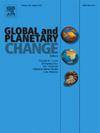Molecular fossil responses to Toarcian (Early Jurassic) climate warming in the high-latitude lacustrine Junggar Basin, China
IF 4
1区 地球科学
Q1 GEOGRAPHY, PHYSICAL
引用次数: 0
Abstract
The Early Jurassic Toarcian Oceanic Anoxic Event (T-OAE), also known as the Jenkyns Event, approximately aligns negative carbon isotope excursions (N-CIE), a stratigraphic marker for Toarcian environmental change. It represents a significant period of greenhouse warming and marine anoxia during the late Early Jurassic, impacting both marine and terrestrial ecosystems. This study explores its effects on terrestrial ecosystems at high latitudes for the first time, specifically focusing on the lacustrine Junggar Basin in northwest China, located at approximately 60°N. By utilizing organic geochemical analyses of fine-grained sedimentary rocks from the Lower Jurassic Sangonghe Formation, we mapped the presence of higher-plant-derived hydrocarbons to reconstruct vegetation shifts before, during, and after the N-CIE interval. Our findings reveal an initial dominance of ferns, with a shift toward gymnosperms such as conifers and cycads during the event, and a subsequent return to fern dominance, as recorded by anomalies in di- and tri-cyclic aromatic hydrocarbon fractions. This suggests significant ecological adaptations and potential recovery or further adaptation following the N-CIE. Our findings underscore the sensitivity of high-latitude terrestrial ecosystems to dramatic climatic events like the T-OAE, emphasizing their importance in understanding past environmental changes and improving predictions of future ecological responses. These results also highlight the suitability of molecular terrestrial plant fingerprints as archives of global environmental changes.
准噶尔盆地高纬度湖相早侏罗世气候变暖的分子化石响应
早侏罗世托瓦纪海洋缺氧事件(T-OAE),又称詹金斯事件,与托瓦纪环境变化的地层标志负碳同位素漂移(N-CIE)基本一致。它代表了早侏罗世晚期温室变暖和海洋缺氧的一个重要时期,对海洋和陆地生态系统都产生了影响。本文首次探讨了气候变化对高纬度地区陆地生态系统的影响,并以60°N左右的准噶尔盆地为研究对象。通过对下侏罗统三工河组细粒沉积岩的有机地球化学分析,我们绘制了高级植物衍生烃的存在图,以重建N-CIE区间之前、期间和之后的植被变化。我们的发现揭示了蕨类植物的初始优势,在事件期间向裸子植物(如针叶树和苏铁)转移,随后又恢复到蕨类植物的优势,这是由二环和三环芳烃馏分的异常记录的。这表明在N-CIE之后,显著的生态适应和潜在的恢复或进一步适应。我们的发现强调了高纬度陆地生态系统对像T-OAE这样的剧烈气候事件的敏感性,强调了它们在理解过去的环境变化和改进未来生态响应预测方面的重要性。这些结果也突出了陆生植物分子指纹图谱作为全球环境变化档案的适用性。
本文章由计算机程序翻译,如有差异,请以英文原文为准。
求助全文
约1分钟内获得全文
求助全文
来源期刊

Global and Planetary Change
地学天文-地球科学综合
CiteScore
7.40
自引率
10.30%
发文量
226
审稿时长
63 days
期刊介绍:
The objective of the journal Global and Planetary Change is to provide a multi-disciplinary overview of the processes taking place in the Earth System and involved in planetary change over time. The journal focuses on records of the past and current state of the earth system, and future scenarios , and their link to global environmental change. Regional or process-oriented studies are welcome if they discuss global implications. Topics include, but are not limited to, changes in the dynamics and composition of the atmosphere, oceans and cryosphere, as well as climate change, sea level variation, observations/modelling of Earth processes from deep to (near-)surface and their coupling, global ecology, biogeography and the resilience/thresholds in ecosystems.
Key criteria for the consideration of manuscripts are (a) the relevance for the global scientific community and/or (b) the wider implications for global scale problems, preferably combined with (c) having a significance beyond a single discipline. A clear focus on key processes associated with planetary scale change is strongly encouraged.
Manuscripts can be submitted as either research contributions or as a review article. Every effort should be made towards the presentation of research outcomes in an understandable way for a broad readership.
 求助内容:
求助内容: 应助结果提醒方式:
应助结果提醒方式:


